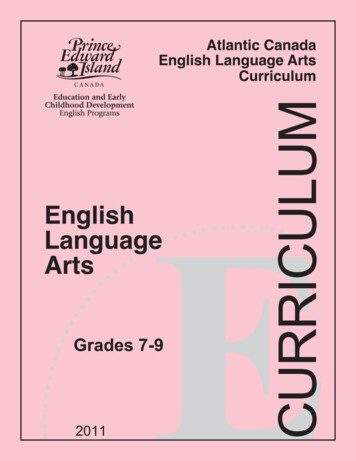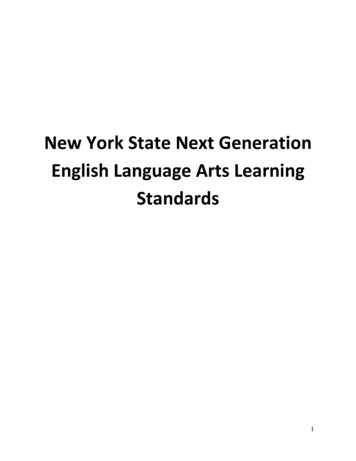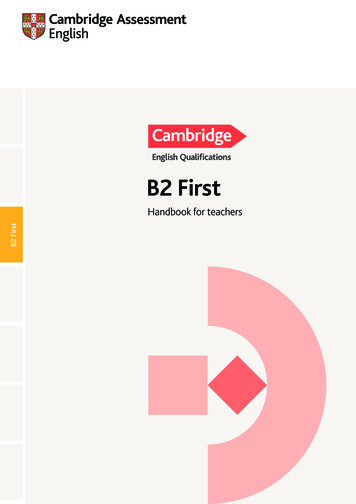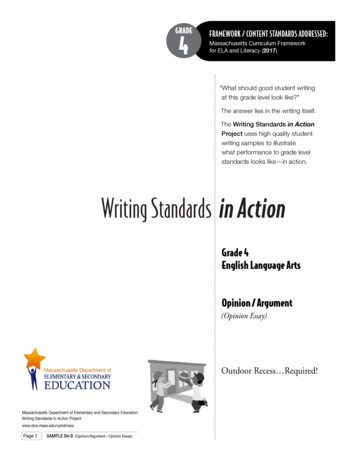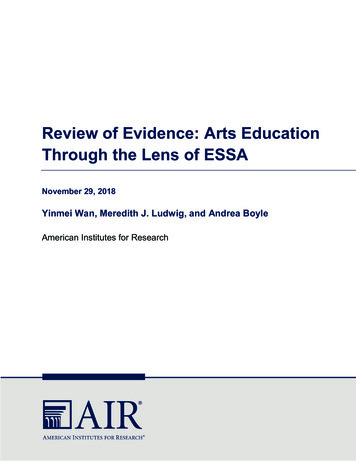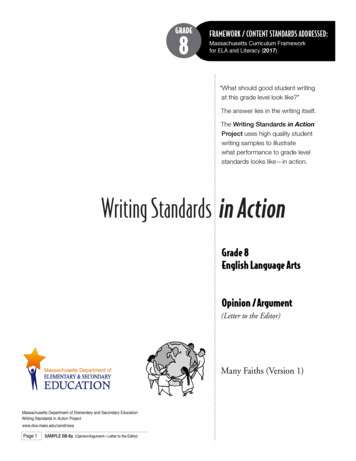
Transcription
GRADE8FRAMEWORK / CONTENT STANDARDS ADDRESSED:Massachusetts Curriculum Frameworkfor ELA and Literacy (2017)“What should good student writingat this grade level look like?”The answer lies in the writing itself.The Writing Standards in ActionProject uses high quality studentwriting samples to illustratewhat performance to grade levelstandards looks like—in action.Grade 8English Language ArtsOpinion /Argument(Letter to the Editor)Many Faiths (Version 1)Massachusetts Department of Elementary and Secondary EducationWriting Standards in Action Projectwww.doe.mass.edu/candi/wsaPage 1SAMPLE B8-8a (Opinion/Argument—Letter to the Editor)
GRADE8Background InformationWriting Sample Title:Many Faiths(Version 1)Text Type and Purpose:Opinion/ArgumentGrade level/Content area:Grade 8 English Language ArtsType of Assignment:Letter to the EditorStandards Addressed:(WCA.6-8.1), (WCA.6-8.4),(WCA.6-8.9), (RI.8.1), (RI.8.8),(RCA-H.6-8.6), (L.8.2), (L.8.3)See descriptions of these standardsin the right column of the next page.Important Note About This Sample:This sample is one of two posted letters to the editor written bydifferent writers in response to the same assignment. Each writerproduces an argument in reaction to an op-ed piece, “Many Faiths,One Truth,” by Tenzin Gyatso, the Dalai Lama.* The samplesdevelop similar arguments but emphasize different elements ofeffective writing.The writer of this sample, Version 1 (Sample B8-8a), agrees with theDalai Lama’s claims by delineating and expanding upon them with acombination of evidence and reasoning expressed precisely and ina formal manner.The writer of Version 2 (Sample B8-8b), relies on adeptly linkedtextual evidence, rather than elaborate reasoning, to give weightto an argument that supports the Dalai Lama’s claims withoutexpanding upon them. For more, read each sample and thecommentary that follows.FRAMEWORK / CONTENT STANDARDS ADDRESSED:Massachusetts Curriculum Frameworkfor ELA and Literacy (2017)STANDARDS-BASED COMMENTARYThe student writing sample that followsincludes standards-based commentary.The commentary found in this columndescribes how the writing meets thestandards in the Massachusetts CurriculumFramework for English Language Artsand Literacy (2017) and other contentframeworks when applicable.Understanding theStandards-Based Commentary1. Grade-specific standardsaddressed are: Listed in the column to the right ofstudent work by strand, grade, andnumber (or number and letter, whereapplicable) Marked by a colored block with a lettercode, also in the column to the right ofstudent workEXAMPLE:2. Colored arrow blocks beneath eachstandard in the right column: Are of the same color and letter code asthe block that marks the standard beingaddressed Mark standards-based commentaryrelated to the standard being addressed Appear in alphabetical orderEXAMPLE:3. Corresponding colored arrow blockswithin the text:CONTINUEDMassachusetts Department of Elementary and Secondary EducationWriting Standards in Action Projectwww.doe.mass.edu/candi/wsaPage 2SAMPLE B8-8a (Opinion/Argument—Letter to the Editor) Set off sections of student work to whichcommentary applies Do not necessarily appear in alphabeticalorder—but where evidence of a particularstandard existsEXAMPLE: (begin)section(end)
GRADE8Background InformationHighlights:This sample of student work meets grade level standards.It demonstrates the following attributes of effective writing.The sample: Introduces a claim and distinguishes it from an opposing claim Develops the claim with clear reasoning and text-basedevidence Demonstrates conciseness appropriate to a letter to the editor Delineates succinctly arguments and specific claims made intwo informational texts Identifies aspects of two informational texts that reveal thepoints of view of their authors Includes precise words and phrases to establish an appropriatestyle and to indicate a formal tone Provides a conclusion that follows from and supports the claimFRAMEWORK / CONTENT STANDARDS ADDRESSED:Massachusetts Curriculum Frameworkfor ELA and Literacy (2017)Writing Standards for Literacy inthe Content Areas 6-12:Grade 6-8, Standard 1 (WCA.6-8.1)Write arguments focused on discipline-specificcontent.EXAMPLE:Writing Standards for Literacy inthe Content Areas 6-12:Grade 6-8, Standard 4 (WCA.6-8.4)Produce clear and coherent writing in whichthe development, organization, and style areappropriate to task, purpose, and audience.EXAMPLE:Writing Standards for Literacy inthe Content Areas 6-12:Grade 6-8, Standard 9 (WCA.6-8.9)Draw evidence from informational texts tosupport analysis, interpretation, reflection,and research.EXAMPLE:Instructional Practices:The teacher used the following practices: Instruction on the characteristics of newspaper editorials andop-ed pieces Discussion of letters to the editor written in response toeditorials and op-ed pieces Instruction regarding expression of a common theme acrossmultiple genresReading Standards for Informational Text:Grade 8, Standard 1 (RI.8.1)Cite the textual evidence that most stronglysupports an analysis of what a text statesexplicitly as well as inferences drawn from thetext, quoting or paraphrasing as appropriate.EXAMPLE:Reading Standards for Informational Text:Grade 8, Standard 8 (RI. 8.8)Delineate and evaluate the argument and specificclaims in a text, assessing whether the reasoningis sound and the evidence is relevant andsufficient; recognize when irrelevant evidence isintroduced.EXAMPLE:Please note:The samples may contain inaccuracies inwording and content or shortcomings in theuse of standard English conventions.Massachusetts Department of Elementary and Secondary EducationWriting Standards in Action Projectwww.doe.mass.edu/candi/wsaPage 3SAMPLE B8-8a (Opinion/Argument—Letter to the Editor)CONTINUEDSTANDARDS ADDRESSED LIST, CONTINUED
Background InformationGRADE8Assignment Description:Students wrote a letter to the editor in response to a New YorkTimes op-ed piece, Many Faiths, One Truth, by Tenzin Gyatso,the Dalai Lama.* Students used textual evidence from the oped, as well as materials of their choosing from a common setof thematically related materials, to develop an argument for oragainst the opinion presented by the Dalai .html? r 0)Intended Audience:Teacher, fellow students, others interested in the topicTime:2 weeksFRAMEWORK / CONTENT STANDARDS ADDRESSED:Massachusetts Curriculum Frameworkfor ELA and Literacy (2017)List of Standards Addressed,Continued:Reading Standards for Literacy inthe Content Areas–History/SocialStudies 6-12: Grade 6-8, Standard 6(RCA-H.6-8.6)Identify aspects of a text that reveal an author’spoint of view or purpose (e.g., loaded language,inclusion or avoidance of particular facts).EXAMPLE:Language Standards:Grade 8, Standard 2 (L.8.2)Demonstrate command of the conventions ofstandard English capitalization, punctuation, andspelling when writing.Writing Process:Pre-writing; organizing; drafting; revising; self-editing;peer-editing/peer response; publishingEXAMPLE:Language Standards:Grade 8, Standard 3 (L.8.3)Use knowledge of language and its conventionswhen writing, speaking, reading, or listening.Materials: Main texts: the op-ed piece, Many Faiths, One Truth,and Akbar in the Mughal EmpireEXAMPLE: Supplemental texts: a set of thematically related materialsincluding brief descriptions of the world’s five major religionsand the poem, Tolerance by Sri Chinmoy Miscellaneous materials: written explanations of the terms,editorial and op-ed; writing warm-up sheet; table on whichstudents could record and clarify confusing words and phrasesfrom the op-ed; graphic organizer; peer review sheet; analytic“Argument Rubric”Please note:The samples may contain inaccuracies inwording and content or shortcomings in theuse of standard English conventions.Massachusetts Department of Elementary and Secondary EducationWriting Standards in Action Projectwww.doe.mass.edu/candi/wsaPage 4SAMPLE B8-8a (Opinion/Argument—Letter to the Editor)END OF BACKGROUNDEND OF STANDARDS ADDRESSED
GRADE8Opinion /ArgumentFRAMEWORK / CONTENT STANDARDS ADDRESSED:Massachusetts Curriculum Frameworkfor ELA and Literacy (2017)STANDARDS-BASED COMMENTARYIn this sample.The writer argues in favor of perspectives expressed in theNew York Times op-ed piece, “Many Faiths, One Truth.” Logicaldelineation and evaluation of arguments made in the op-ed andin a second source provide support for the writer’s claim thatcompassion and tolerance are essential to peaceful coexistence.Careful organization and citation of salient factual informationenable the writer to develop a concise letter to the editor thatdemonstrates purposeful coherence, clarity, and cohesion.The writer includes precise words and phrases to establish anappropriate style and to indicate a formal tone suitable to a letterwritten to make serious assertions about a complex topic.Understanding theStandards-Based CommentaryThe student writing sample that begins on thispage includes in this column standards-basedcommentary describing how the writing meetsthe standards in the Massachusetts CurriculumFramework for English Language Arts andLiteracy (2017) and other content frameworks,when applicable. Where they apply, substandards marked by letters are included.Evidence for the commentary is noted in thetext of the student writing using color-coded,numbered ‘begin’ and ‘end’ arrows.For example:marks the beginning andmarksthe end of the relevant section in the text.Please note that the labeled arrows in the textdo not necessarily appear in alphabetical order.Many Faiths (Version 1)(Reaction to the following: Gyatso, Tenzin. “Many Faiths, OneTruth.” The New York Times, May 24, yatso.html? r 0)Writing in the Content Areas.Grade 6-8, Standard 1WCA.6-8.1.aIntroduce claim(s) about a topic or issue,acknowledge and distinguish the claim(s) fromalternate or opposing claims/critiques, andorganize the reasons and evidence logicallyin paragraphs and section.Dear Editor,I am an eighth grade student at Middle Schoolwho was moved by the Dalai Lamas’ claim, that harmony andWRITING SAMPLE CONTINUESA1 Examples: 1The writer introduces a clear claim (As ourtechnology continues to advance, we are moreinclined to spread our conflicting opinions andviews to people around the world. This is whywe must understand that the five major religionsall link through compassion. We need to takeadvantage of this.).A2 Examples: 1Massachusetts Department of Elementary and Secondary EducationWriting Standards in Action Projectwww.doe.mass.edu/candi/wsaPage 5SAMPLE B8-8a (Opinion/Argument—Letter to the Editor)The writer alludes to an opposing claim(.rather than seeking out the differences.).MORE COMMENTARY
GRADE8Opinion/ArgumentFRAMEWORK / CONTENT STANDARDS ADDRESSED:Massachusetts Curriculum Frameworkfor ELA and Literacy (2017)STANDARDS-BASED COMMENTARYcompassion will lead to a more tolerant world.technology continues to advance,As ourwe are more inclinedto spread our conflicting opinions and views to people around theworld.This is why we must understandthat the five majorreligions all link through compassion. We need to take advantage ofthisrather than seeking out the differences.In my study of India, I discovered a leader named Akbarwho promoted religious and cultural tolerance.He encouragedWriting in the Content Areas.Grade 6-8, Standard 1(continued)A3 Examples: 1The writer provides context for the claim byalluding to ideas around which the letter willbe organized (I am an eighth grade studentat Middle School who was moved bythe Dalai Lamas’ claim, that harmony andcompassion will lead to a more tolerant world.).Writing in the Content Areas.Grade 6-8, Standard 1 ANDReading Informational Text.Grade 8, Standard 1 AND Standard 8WCA.6-8.1.b ANDRI.8.1 ANDRI.8.8WCA.6-8.1.bSupport claim(s) with logical reasoning andrelevant, accurate data and evidence thatdemonstrate an understanding of the topicor text, using credible sources.RI.8.1Cite the textual evidence that most stronglysupports an analysis of what a text statesexplicitly as well as inferences drawn from thetext, quoting or paraphrasing as appropriate.RI.8.8Delineate and evaluate the argument andspecific claims in a text, assessing whetherthe reasoning is sound and the evidenceis relevant and sufficient; recognize whenirrelevant evidence is introduced.B1 Examples: 1WRITING SAMPLE CONTINUESMassachusetts Department of Elementary and Secondary EducationWriting Standards in Action ProjectThe writer provides contextual support for theclaim by introducing the ideas of a scholarwho made assertions similar to those of theDalai Lama (In my study of India, I discovereda leader named Akbar who promoted religiousand cultural tolerance.).www.doe.mass.edu/candi/wsaPage 6SAMPLE B8-8a (Opinion/Argument—Letter to the Editor)MORE COMMENTARY
Opinion/ArgumentGRADE8FRAMEWORK / CONTENT STANDARDS ADDRESSED:Massachusetts Curriculum Frameworkfor ELA and Literacy (2017)STANDARDS-BASED COMMENTARYtalk between religious leaders to discuss views and philosophies.Akbar states “It cannot be wisdom to assert one faithover another the wise person makes justice his guide and learnsfrom all religions.”He implies thatwe not onlyshould learn from what we already know, but we must step beyondour comfort zone and educate through other perspectives as well.No one religion owns all knowledge.to the view thatAkbarcontributedunity is what guides us to a more tolerantcoexistence.Writing in the Content Areas.Grade 6-8, Standard 1 ANDReading Informational Text.Grade 8, Standard 1 AND Standard 8(continued)B2 Examples: 1The writer cites relevant textual evidence anddraws reasonable inferences that delineate andexpand upon the argument made by Akbar(Akbar states “It cannot be wisdom to assertone faith over another the wise person makesjustice his guide and learns from all religions.”He implies that we not only should learn fromwhat we already know, but we must step beyondour comfort zone and educate through otherperspectives as well. No one religion ownsall knowledge. Akbar contributed to the viewthat unity is what guides us to a more tolerantcoexistence.).B3 Examples: 1The writer provides additional context for themajor claim of the letter (From the article ManyFaiths, One Truth, the Dalai Lama has conversedwith a wide spread of people from differentreligions and cultural back rounds.).WRITING SAMPLE CONTINUESMassachusetts Department of Elementary and Secondary EducationWriting Standards in Action Projectwww.doe.mass.edu/candi/wsaPage 7SAMPLE B8-8a (Opinion/Argument—Letter to the Editor)MORE COMMENTARY
Opinion/ArgumentGRADE8FRAMEWORK / CONTENT STANDARDS ADDRESSED:Massachusetts Curriculum Frameworkfor ELA and Literacy (2017)STANDARDS-BASED COMMENTARYFrom the article Many Faiths, One Truth, the Dalai Lamahas conversed with a wide spread of people from different religionsand cultural back rounds.He found thatthe common thread of compassion connects all five majorreligions.Each religion has a different way of expressing itspractice of compassion. Christianity shows it through Jesus’ actsand teaching. The Dalia Lama had spoken to Merton the Monkyou said, “His miracle of the loaves and fishes, his healing andhis teachings are all motivated by the desire to relive suffering”.Writing in the Content Areas.Grade 6-8, Standard 1 ANDReading Informational Text.Grade 8, Standard 1 AND Standard 8(continued)B4 Examples: 1The writer cites relevant textual evidence anddraws reasonable inferences that delineate andexpand upon the argument made by the DalaiLama (He found that the common thread ofcompassion connects all five major religions.Each religion has a different way of expressingits practice of compassion. Christianity showsit through Jesus’ acts and teaching. The DaliaLama had spoken to Merton the Monk you said,“His miracle of the loaves and fishes, his healingand his teachings are all motivated by the desireto relive suffering”. Buddhism also shows theirdedication towards compassion because theirentire religion is based off of giving up wordydesires, so people will no longer suffer. FromJudaism who speaks through the Talmud, Islamfrom the Quran and Hindus in the BhagavadGida, they all express that compassion is a coreprinciple in each religion. Intolerance may beas old as religion itself, but this does not meanwe should follow blindly in its acts of evil. Weall need to accept each other for who we are,to keep the world safe from all judgment andviolence.).WRITING SAMPLE CONTINUESMassachusetts Department of Elementary and Secondary EducationWriting Standards in Action Projectwww.doe.mass.edu/candi/wsaPage 8SAMPLE B8-8a (Opinion/Argument—Letter to the Editor)MORE COMMENTARY
Opinion/ArgumentGRADE8FRAMEWORK / CONTENT STANDARDS ADDRESSED:Massachusetts Curriculum Frameworkfor ELA and Literacy (2017)STANDARDS-BASED COMMENTARYBuddhism also shows their dedication towards compassion becausetheir entire religion is based off of giving up wordy desires, so peoplewill no longer suffer. From Judaism who speaks through the Talmud,Islam from the Quran and Hindus in the Bhagavad Gida,all express thatcompassion is a core principle in each religion.Intolerance may be as old as religion itself,meantheybut this does notwe should follow blindly in its acts of evil.Weall need to accept each other for who we are, to keep the worldsafefrom all judgment and violence.Writing in the Content Areas.Grade 6-8, Standard 1 ANDLanguage. Grade 8, Standard 3WCA.6-8.1.d ANDL.8.3WCA.6-8.1.dEstablish and maintain a style appropriateto audience and purpose (e.g., formal foracademic writing).L.8.3Use knowledge of language and itsconventions when writing, speaking, reading,or listening.C Examples: 1 . 2 . 3 . 4 . 5 . 6 . 7The writer includes precise words and phrasesthat, despite occasional abrupt transitions,establish an appropriate style and indicate aformal tone suitable to a letter written to makeserious assertions about a complex topic(.we are more inclined. This is why we mustunderstand. He implies that. contributed to theview that. He found that. they all express that.but this does not mean.)Writing in the Content Areas.Grade 6-8, Standard 1WCA.6-8.1.eProvide a concluding statement or sectionthat follows from and supports the argumentpresented.D Examples: 1WRITING SAMPLE CONTINUESMassachusetts Department of Elementary and Secondary EducationWriting Standards in Action Projectwww.doe.mass.edu/candi/wsaPage 9SAMPLE B8-8a (Opinion/Argument—Letter to the Editor)The writer provides a conclusion that, in spiteof a lack of transitional elements, distills theargument made in the sample, supports theclaim, and references a counter claim (Crueltyand Intolerance can lead to an unstable livingenvironment for love to grow. Obtainingharmony and unity, to express compassionis the foundation for a peaceful world. As wecome more interconnected, instead of spreadingopposing views we should speak of thesimilarities. Tolerance is what will make the worldone, so we can all get along.).MORE COMMENTARY
Opinion/ArgumentGRADE8FRAMEWORK / CONTENT STANDARDS ADDRESSED:Massachusetts Curriculum Frameworkfor ELA and Literacy (2017)STANDARDS-BASED COMMENTARYCruelty and Intolerance can lead to an unstable livingenvironment for love to grow. Obtaining harmony and unity, toexpress compassion is the foundation for a peaceful world. As wecome more interconnected, instead of spreading opposing viewsWriting in the Content Areas.Grade 6-8, Standard 4WCA.6-8.4Produce clear and coherent writing in whichthe development, organization, and style areappropriate to task, purpose, and audience.Overall text referencewe should speak of the similarities. Tolerance is what will make theThe writer produces a suitably formal, conciseletter to the editor a that makes a clear argumentin response to an op-ed piece.world one, so we can all get along.Note: Comment refers to the piece as a wholerather than a specific example within the text.Writing in the Content Areas.Grade 6-8, Standard 9 ANDReading in the Content Areas–History/Social Studies. Grade 6-8, Standard 6WCA.6-8.9 ANDRCA-H.6-8.6WCA.6-8.9Draw evidence from informational texts tosupport analysis, interpretation, reflection,and research.RCA-H.6-8.6Identify aspects of a text that reveal anauthor’s point of view or purpose (e.g.,loaded language, inclusion or avoidance ofparticular facts).F1 Examples: 1 . 2END OF WRITING SAMPLEThe writer includes and synthesizes textualevidence to identify Akbar’s point of viewregarding religious tolerance and coexistence(Akbar states “It cannot be wisdom to assert onefaith over another the wise person makes justicehis guide and learns from all religions.” Akbarcontributed to the view that unity is what guidesus to a more tolerant coexistence.).Massachusetts Department of Elementary and Secondary EducationWriting Standards in Action Projectwww.doe.mass.edu/candi/wsaPage 10SAMPLE B8-8a (Opinion/Argument—Letter to the Editor)MORE COMMENTARY
Opinion/ArgumentGRADE8FRAMEWORK / CONTENT STANDARDS ADDRESSED:Massachusetts Curriculum Frameworkfor ELA and Literacy (2017)STANDARDS-BASED COMMENTARYWriting in the Content Areas.Grade 6-8, Standard 9 ANDReading in the Content Areas-History/Social Studies. Grade 6-8, Standard 6(continued)F2 Examples: 1 . 2The writer includes and synthesizes textualevidence to identify the Dalai Lama’s similarpoint of view regarding religious toleranceand coexistence (. the common thread ofcompassion connects all five major religions.We all need to accept each other for who we are,to keep the world safe.).Language Standards.Grade 8, Standard 2L.8.2Demonstrate command of the conventions ofstandard English capitalization, punctuation,and spelling when writing.Overall text referenceThe writer’s control of standard Englishcapitalization, punctuation, and spellingenhances the clarity of this sample.Note: Comment refers to the piece as a wholerather than a specific example within the text.Massachusetts Department of Elementary and Secondary EducationWriting Standards in Action Projectwww.doe.mass.edu/candi/wsaPage 11SAMPLE B8-8a (Opinion/Argument—Letter to the Editor)END OF COMMENTARY
English Language Arts Opinion /Argument (Letter to the Editor) Many Faiths (Version 1) FRAMEWORK / CONTENT STANDARDS ADDRESSED: Massachusetts Curriculum Framework for ELA and Literacy (2017) Page 1 (Opinion/Argument—Letter to the Editor)SAMPLE B8-8a GRADE 8 Massachusetts
